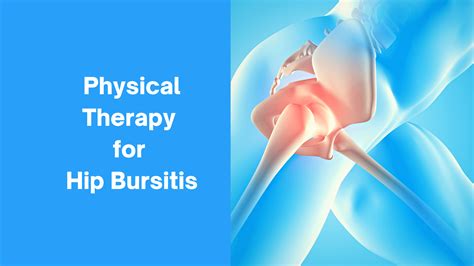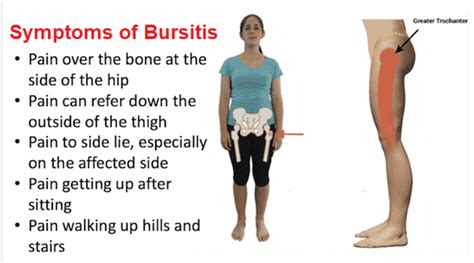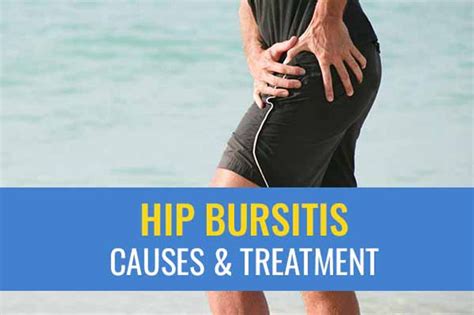Intro
Find effective Hip Bursitis Relief Solutions, including treatments, exercises, and therapies to alleviate hip pain, inflammation, and tenderness, promoting joint mobility and reducing bursa discomfort.
The hip joint is a complex structure that allows for a wide range of motion, making it possible to perform daily activities with ease. However, this joint is also prone to various types of injuries and conditions, including hip bursitis. Hip bursitis is a common condition characterized by inflammation of the bursae, which are fluid-filled sacs that cushion the joints and reduce friction between bones, tendons, and muscles. This condition can cause significant pain and discomfort, making it essential to explore effective relief solutions.
Hip bursitis can be caused by a variety of factors, including repetitive motion, direct blows to the hip, or conditions such as arthritis. The symptoms of hip bursitis can vary from person to person but often include pain and tenderness on the outside of the hip, swelling and redness, and limited mobility. If left untreated, hip bursitis can lead to chronic pain and reduced mobility, making it challenging to perform daily activities. Fortunately, there are several relief solutions available to help manage the symptoms of hip bursitis and promote healing.
The importance of seeking medical attention for hip bursitis cannot be overstated. A healthcare professional can diagnose the condition and recommend a treatment plan that addresses the underlying causes of the inflammation. In addition to medical treatment, there are several self-care strategies that can help alleviate the symptoms of hip bursitis. These include applying ice to the affected area, taking regular breaks to rest and stretch, and avoiding activities that aggravate the condition. By combining medical treatment with self-care strategies, individuals can effectively manage the symptoms of hip bursitis and promote healing.
Hip Bursitis Causes and Risk Factors

Repetitive Motion and Hip Bursitis
Repetitive motion is a common cause of hip bursitis. Activities such as running, cycling, and swimming can cause the bursae to become inflamed, leading to pain and discomfort. Individuals who participate in these activities on a regular basis are at a higher risk of developing hip bursitis. To reduce the risk of hip bursitis, it is essential to take regular breaks to rest and stretch.Direct Blows to the Hip and Hip Bursitis
Direct blows to the hip can also cause the bursae to become inflamed, leading to hip bursitis. Falls or direct blows to the hip can cause the bursae to become inflamed, leading to pain and discomfort. Individuals who have experienced a fall or direct blow to the hip are at a higher risk of developing hip bursitis.Hip Bursitis Symptoms and Diagnosis

Physical Examination and Hip Bursitis Diagnosis
A physical examination is an essential part of diagnosing hip bursitis. During the examination, the healthcare professional will assess the range of motion in the hip and look for signs of inflammation, such as swelling and redness. The healthcare professional may also perform a series of tests to determine the cause of the symptoms.Medical History and Hip Bursitis Diagnosis
A medical history is also an essential part of diagnosing hip bursitis. The healthcare professional will ask questions about the individual's medical history, including any previous injuries or conditions that may have contributed to the development of hip bursitis. The healthcare professional may also ask questions about the individual's lifestyle, including their occupation and recreational activities.Hip Bursitis Treatment Options

Medication and Hip Bursitis Treatment
Medication is often the first line of treatment for hip bursitis. Over-the-counter pain relievers, such as ibuprofen and naproxen, can help reduce pain and inflammation. In some cases, the healthcare professional may prescribe stronger pain relievers or corticosteroid injections to reduce inflammation.Physical Therapy and Hip Bursitis Treatment
Physical therapy is also an essential part of treating hip bursitis. A physical therapist can help individuals develop a series of exercises to strengthen the muscles around the hip and improve flexibility. The physical therapist may also use techniques such as ultrasound and heat therapy to reduce pain and inflammation.Hip Bursitis Relief Solutions

Applying Ice and Hip Bursitis Relief
Applying ice to the affected area is a simple and effective way to reduce pain and inflammation. The ice should be applied for 15-20 minutes at a time, several times a day. It is essential to wrap the ice in a towel to avoid direct contact with the skin.Taking Regular Breaks and Hip Bursitis Relief
Taking regular breaks to rest and stretch is also an essential part of managing the symptoms of hip bursitis. Individuals should take regular breaks to stretch and move around, which can help reduce stiffness and improve mobility.Hip Bursitis Prevention Strategies

Maintaining a Healthy Weight and Hip Bursitis Prevention
Maintaining a healthy weight is an essential part of preventing hip bursitis. Excess weight can put additional stress on the joints, increasing the risk of developing hip bursitis. Individuals should aim to maintain a healthy weight through a combination of diet and exercise.Engaging in Regular Exercise and Hip Bursitis Prevention
Engaging in regular exercise is also an essential part of preventing hip bursitis. Exercise can help strengthen the muscles around the hip and improve flexibility, reducing the risk of developing hip bursitis. Individuals should aim to engage in regular exercise, such as walking or swimming, to help reduce the risk of hip bursitis.What are the symptoms of hip bursitis?
+The symptoms of hip bursitis can vary from person to person but often include pain and tenderness on the outside of the hip, swelling and redness, and limited mobility.
How is hip bursitis diagnosed?
+Hip bursitis is diagnosed through a physical examination and medical history. The healthcare professional may also perform a series of tests to determine the cause of the symptoms.
What are the treatment options for hip bursitis?
+The treatment options for hip bursitis include medication, physical therapy, and surgery. The treatment plan will depend on the underlying cause of the condition and the severity of the symptoms.
In
Final Thoughts

